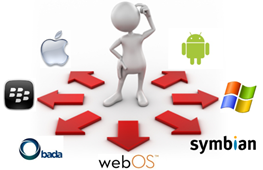
Lesson Plan: Unit - 01
Subject: P15A2AAD - Android Application Development
Topic of Study: Architecture of Android, Exploring Android SDK
Grade/Level: Master of Computer Applications
Objective: To understand architecture of Android Operating system with SDK components
Time Allotment: 55 Minutes
- What is APK?:
- APK files are a variant of the JAR file format, which are built on the ZIP file format, with a .apk file extension.
- APK (Android Package) file is a file format which is created by Google.
- APK files contain the code files, resource files and the Android Manifest XML file extension.
- Figure:
- Exa.
- For Windows = .exe
- For Mac OS X = .dmg
- For Symbian and Java phones = .sis, .sisx and .jar
- For Android smartphones = .apk
- Architecture of Android OS
- There are various layers that makeup Android OS.
- Figure:
- Application
- You will find applications that ship with the Android device (such as Phone, Contacts, Browser, etc.), as well as applications that you download and install from the Android Market.
- Application Framework
- Exposes the various capabilities of the Android OS to application developers so that they can make use of them in their applications
- Libraries
- Provides the main features of an Android OS. For exa. the SQLite library provides database and The WebKit library provides functionalities for web browsing.
- Android Runtime
- Android runtime provides a set of core libraries that enable developers to write Android apps using the Java programming language.
- The Android runtime also includes the Dalvik virtual machine, which enables every Android application to run in its own process, with its own instance of the Dalvik virtual machine.
- Dalvik is a specialized virtual machine designed specifically for Android and optimized for battery-powered mobile devices with limited memory and CPU
- Linux Kernel
- This is the kernel on which Android is based. This layer contains all the low-level device drivers for the various hardware components of an Android device.
- Exploring Android SDK
- The Android SDK is upgraded from time to time.
- You can easily upgrade the Android SDK and tools from within Eclipse using the Android SDK and AVD Manager.
- With each new version of the SDK, Google provides the following useful documents:
- An Overview of Changes: A brief description of major changes to the SDK.
- An API Diff Report: A complete list of specific changes to the SDK.
- Release Notes: A list of known issues with the SDK
- It comes with five major components.
- ASDK License Agreement
- It’s a contract between you and Google
- There are following points for developers.
- Rights granted
- SDK Usage
- SDK changes and backward compatibility
- Android application developer rights
- Android application privacy requirements
- Android application malware requirements
- Additional terms for specific Google APIs
- Develop at your own risk
- Android Documentation
- A local copy under the /docs sub folder on disk
- There are seven main sections.
- The Home tab, The SDK tab
- The Dev Guide tab, The Reference tab
- The Resource tab, The Videos tab
- The Blog tab
- Application Framework
- Its provide several important package from android.jar.
- Table:
- Android Tools
- Its provide tool to design, develop, debug and deploy your android application.
- ADT plug in are found in Eclipse under Window > Preference > Android
- Android SDK and AVD Manager
- To manage multiple version of SDK and AVD configuration
- Android Emulator
- A software which work like an actual hardware.
- Dalvik Debug Monitor Server (DDMS)
- A command line tool that you direct access to the device.
- Android Debug Bridge (ADB)
- A client server tool used to enable developers to Android code on Emulator.
- Android Hierarchy Viewer
- A visual tool that illustrate layout component relationship for user interface.
- Other tools
- A Draw Nine Patch tool enable you to design PNG images.
- Sample Applications
- The sample application located in /sample subdirectory.
- ApiDemos
- Snake
- NotePad
- LunarLander







